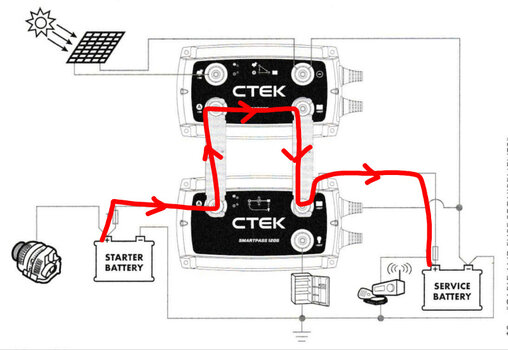The Grenadier Forum
Register a free account today to become a member! Once signed in, you'll be able to contribute to the community by adding your own topics, posts, and connect with other members through your own private inbox! INEOS Agents, Dealers or Commercial vendors please use the contact us link at the bottom of the page.
You are using an out of date browser. It may not display this or other websites correctly.
You should upgrade or use an alternative browser.
You should upgrade or use an alternative browser.
(The battery and monitor thread )Car dead in the middle of the woods
I don't know if
Oh I don't know, I think his original response was (broadly) more accurate .....
Upvote
0
See attached. The lhs connection bar from the Smartpass is the 250's 'power supply', and the Smartpass itself is fed by the alternator via the starter battery. The current flows through the 250 to the service battery as per the attached sketch. The 250 is charging the service battery via this route and adjusting the voltage and current as it passes through. The Smartpass is also charging the service battery but directly through its internal connection to its rhs connection bar terminal, but it doesn't/can't adjust the voltage being supplied from the alternator. Make sense? Or have I not understood the question.I still cant see how the 250 can both accept current through the + connection to the 120, and boost the voltage back on the same connection, and that without even its own power supply - I hate having to put things down to ‘magic happens’, so if you can see why im still puzzled by effectively one connection (plus ground) and no direct route to service battery, then feel free to put me out of my misery.
Attachments
Last edited:
Upvote
0
After 5h charging CTEK MX5.0 said „full“, Grenny shows 93%I charge at the moment my Grenadier with CTEK MX 5.0 via Points under the Bonnet, after approximately 3h , smartpass start to charge the auxiliary battery.
SOC was at the beginning 85% on the console.View attachment 7821095
Upvote
0
Try connecting directly to the auxiliary/service battery and see if the Ctek starts charging again, and if it quickly goes to absorption or float or stays in bulk mode for some time.After 5h charging CTEK MX5.0 said „full“, Grenny shows 93%
Upvote
0
- Local time
- 9:35 AM
- Joined
- Dec 22, 2022
- Messages
- 774
Thank you everyone for the fantastic posts. Unfortunately, I am illiterate in auto electrics. Nevertheless, I plan to install a second cigarette box for my Engel fridge in the right backspace. Question: does it make sense to simply lay a fused cable directly from the auxiliary battery to protect the starter battery and only operate the refrigerator with it? Barney.
Upvote
0
- Local time
- 8:35 AM
- Joined
- Jul 27, 2022
- Messages
- 6,005
Yes, just more gaslighting from Ineos...Wasn’t for me, I think they come with the Smartpass,not the D250SE
Upvote
0
Thank you everyone for the fantastic posts. Unfortunately, I am illiterate in auto electrics. Nevertheless, I plan to install a second cigarette box for my Engel fridge in the right backspace. Question: does it make sense to simply lay a fused cable directly from the auxiliary battery to protect the starter battery and only operate the refrigerator with it? Barney.
I think, it's a new vehicle. it has a second/auxiliary battery to which you should be able to connect auxiliary devices, which is what you are doing and they should work.
Having read through this thread and others I would say there is a problem with the twin battery charging system installed into the car.
The batteries are OK
You shouldn't have to be running cables and protecting the main battery.
Something is wrong, not right ... there bis an english phrase for it .... 'It's fucked' (add 'up' for the American version or 'mate' for the Australian).
I think that the combination of the 'smart alternator' and the CTEK dual battery charging system isn't working. The ECU see's the main battery as the only battery on board and essentially cuts off the charging current (in the name of emissions conservation) and the secondary battery doesn't charge or at least doesn't charge enough to be of any use for any length of time.
When it does connect to the main battery, or main+aux pairing, the ECU believes everything is 100% and shuts down the alternator.
I don't have a Grenny so this is pure speculation.
It's a new vehicle.
Take it back to the organisation that you bought it from and they should be able to fix it, or tell you that it has a capability which is below your expectations but matches their technical description.
When they come up with that line, take it to a good auto electrician, pay them, and he/she will sort it out for you.
Upvote
0
- Local time
- 9:35 AM
- Joined
- Dec 22, 2022
- Messages
- 774
I understand what you write and mean. Maybe I'll do a stress test under home conditions. I'm looking for a solution too. But I will never give the car back. Too bad you don't have one (yet). ;-)I think, it's a new vehicle. it has a second/auxiliary battery to which you should be able to connect auxiliary devices, which is what you are doing and they should work.
Having read through this thread and others I would say there is a problem with the twin battery charging system installed into the car.
The batteries are OK
You shouldn't have to be running cables and protecting the main battery.
Something is wrong, not right ... there bis an english phrase for it .... 'It's fucked' (add 'up' for the American version or 'mate' for the Australian).
I think that the combination of the 'smart alternator' and the CTEK dual battery charging system isn't working. The ECU see's the main battery as the only battery on board and essentially cuts off the charging current (in the name of emissions conservation) and the secondary battery doesn't charge or at least doesn't charge enough to be of any use for any length of time.
When it does connect to the main battery, or main+aux pairing, the ECU believes everything is 100% and shuts down the alternator.
I don't have a Grenny so this is pure speculation.
It's a new vehicle.
Take it back to the organisation that you bought it from and they should be able to fix it, or tell you that it has a capability which is below your expectations but matches their technical description.
When they come up with that line, take it to a good auto electrician, pay them, and he/she will sort it out for you.
Upvote
0
Whilst I am firmly in the “not a clue camp”, there have been real experts looking at these systems, including some of us owners, Black Sheep, Letech etc.
Has no one mentioned that these are or may be possibly wired up wrong. I expect that when the Aussies get hold of theirs, this will be picked up straight away, as they are much more accustomed to running dual battery systems etc.
Has no one mentioned that these are or may be possibly wired up wrong. I expect that when the Aussies get hold of theirs, this will be picked up straight away, as they are much more accustomed to running dual battery systems etc.
Upvote
0
(cough), no, I dare say.Yes, if you're going to run a fridge it's pretty well essential.
If the 120S is wired correctly by INEOS (which I prosume) and if there is no glitch in the installation, the 120S "load" output is the right point to connect a fridge (and any other dispensable load as well).
This applies to @Barney's quesion as well.
I'd only install a 250SE if I had solar panels and want to integrate them correctly in the installation.
Upvote
0
I see in another post I can't find at present that the smartpass red wire that is normally connected if the vehicle has a smart alternator is not connected in the Ineos on the assumption the vehicle is managing alternator output to include charging of the aux battery. Perhaps the red wire does need connecting to 12 volts? Does anyone know if the 250se is added that its red wire will need connecting to indicate a smart alternator?
If no one's answered this... CTek confirmed in a phone call I had with them a few weeks back that the small red wire of the Smartpass needs to be connected to an Ign On source if the vehicle has a smart alternator. IIRC the tec said without that connection the Smartpass can't create the correct demand on the alternator to charge the second battery as the alternator will only see the primary/starting battery.
Upvote
0
OK, Please help with the abbreviations for those of us that are not sure of what your are writing about.If no one's answered this... CTek confirmed in a phone call I had with them a few weeks back that the small red wire of the Smartpass needs to be connected to an Ign On source if the vehicle has a smart alternator. IIRC the tec said without that connection the Smartpass can't create the correct demand on the alternator to charge the second battery as the alternator will only see the primary/starting battery.
What is Ign? Is it an Ignition On source and if so where would this be so we could connect the red wire.
What is 11RC? Is 11RC the name of the tec?
Thank You.
Upvote
0
Cheers, perhaps someone with a car fitted with smartpass could have their dealer check this out as a couple of owners have confirmed the smartpass red wire which as indicated by Ctek above (and shown in the smartpass manual) needs to be connected to 12 volts for 'smart alternators' is NOT connected. I'm yet to receive my vehicle but it needs to be checked out.If no one's answered this... CTek confirmed in a phone call I had with them a few weeks back that the small red wire of the Smartpass needs to be connected to an Ign On source if the vehicle has a smart alternator. IIRC the tec said without that connection the Smartpass can't create the correct demand on the alternator to charge the second battery as the alternator will only see the primary/starting battery.
Upvote
0
What is Ign? Is it an Ignition On source ...
Yes but I probably just made that abbreviation up out of sheer keyboard laziness.
Ctek names a connection point but the tec guy on the phone just said any place that only gets power when the ignition is on. I didn't ask whether the connection must stay live during "start" functioning. A simple fuse tap on one of the under seat fuses should be good enough but a call to Ctek by an actual Grenadier owner would confirm.
What is 11RC? Is 11RC the name of the tec?
Thank You.
IIRC = If I Remember Correctly. Should be lower lower case to be correct.
Danged whipper-snapper Millennials have polluted my brain.
Last edited:
Upvote
0
That’s answered it, in my questions I said/assumed that the 2 connections were + and ground, but in fact they are both (all 4) part of the + circuit. I suppose a diode is enough to stop 2 different voltages, one from each ctek, attempting to flow unidirectionally, so it all makes much more sense now thank you!See attached. The lhs connection bar from the Smartpass is the 250's 'power supply', and the Smartpass itself is fed by the alternator via the starter battery. The current flows through the 250 to the service battery as per the attached sketch. The 250 is charging the service battery via this route and adjusting the voltage and current as it passes through. The Smartpass is also charging the service battery but directly through its internal connection to its rhs connection bar terminal, but it doesn't/can't adjust the voltage being supplied from the alternator. Make sense? Or have I not understood the question.
Last observation...why is this not a single device to start with!!
Upvote
0
- Local time
- 5:35 PM
- Joined
- Aug 24, 2022
- Messages
- 2,458
It may be that, I doubt they “pocket them” more likely discard. But also possible/probable that they buy in bulk from CTEK without the boxes and connectors.@DCPU are you saying that when fitting the Smartpass 120S that INEOS remove the 2 x connection plates and 3 x M8 connection screws and 'pocket' them rather than fitting them to the car or leaving them in the box ?
Upvote
0
- Local time
- 5:35 PM
- Joined
- Aug 24, 2022
- Messages
- 2,458
It’s a bit unique to CTEK in a way, but also not. Many basic dual battery systems just use a voltage sensitive relay which connects the batteries until it drops to a certain voltage and then isolates. The Smartpass replaces that but is a bit smarter than your average VSR. The next step up is to add a dc/dc charger which adds a solar regulator and smarter charging modes and better ability to handle smart alternators etc which is essentially what the D250SE is. So CTEK is basically a dc/dc charger plus a smarter than average VSRThat’s answered it, in my questions I said/assumed that the 2 connections were + and ground, but in fact they are both (all 4) part of the + circuit. I suppose a diode is enough to stop 2 different voltages, one from each ctek, attempting to flow unidirectionally, so it all makes much more sense now thank you!
Last observation...why is this not a single device to start with!!
Upvote
0
- Local time
- 5:35 PM
- Joined
- Aug 24, 2022
- Messages
- 2,458
I’m not sure it’s actually wrong, I think INEOS has just made some choices about what to connect to what, that many if us would have chosen to do differently. Once I get mine and have a chance to properly understand it I will likely make a few changes.I think, it's a new vehicle. it has a second/auxiliary battery to which you should be able to connect auxiliary devices, which is what you are doing and they should work.
Having read through this thread and others I would say there is a problem with the twin battery charging system installed into the car.
The batteries are OK
You shouldn't have to be running cables and protecting the main battery.
Something is wrong, not right ... there bis an english phrase for it .... 'It's fucked' (add 'up' for the American version or 'mate' for the Australian).
I think that the combination of the 'smart alternator' and the CTEK dual battery charging system isn't working. The ECU see's the main battery as the only battery on board and essentially cuts off the charging current (in the name of emissions conservation) and the secondary battery doesn't charge or at least doesn't charge enough to be of any use for any length of time.
When it does connect to the main battery, or main+aux pairing, the ECU believes everything is 100% and shuts down the alternator.
I don't have a Grenny so this is pure speculation.
It's a new vehicle.
Take it back to the organisation that you bought it from and they should be able to fix it, or tell you that it has a capability which is below your expectations but matches their technical description.
When they come up with that line, take it to a good auto electrician, pay them, and he/she will sort it out for you.
1. Am adding the D250SE and make sure it is all wires properly with alternator connections correct. I will then make up a solar input cable, I will just leave this under the seat as I will likely only use in camp so won’t bother trying to route up to roof or anything
2. Will add a cable to the load connection of the SmartPass and run to the rear Load space with an Anderson plug for my fridge.
3. Will see if it possible to reroute the 3 roof connections power source to the Smartpass load connector as well so I can use camp lights etc from there.
Upvote
0
They get 2 sales!That’s answered it, in my questions I said/assumed that the 2 connections were + and ground, but in fact they are both (all 4) part of the + circuit. I suppose a diode is enough to stop 2 different voltages, one from each ctek, attempting to flow unidirectionally, so it all makes much more sense now thank you!
Last observation...why is this not a single device to start with!!
The Dumbpass came later and is marketed as an 80A boost to charging so in theory a max of 100A when used with the 250SE. Which is fine if you have a large bank of batteries in a motorhome or a 200Ah lithium drop-in a touring truck. The 100A will never be achieved in the IG's setup with the EFB batteries. The unit should be ideal though for lithium LiFePO4 batteries with a built-in battery mgmt system (BMS) as it should charge at the full 80A from the alternator at no more than 14.4V which is acceptable for those batteries, but I'd still include the 250SE to manage the charge once the battery is nearing full and you get the extra 20A, plus the solar option.
The unit also added the ability to connect the starter and service batteries for starting. The 250SE can't do this.
Ineos likely chose the unit as it was a convenient solution to link the two EFB batteries for start assist and charging. It just doesn't do a good job of charging the service battery due to the smart alternator throttling back the voltage. The 250SE fixes that.
Upvote
0
Similar threads
- Replies
- 14
- Views
- 728
- Replies
- 52
- Views
- 4K
- Replies
- 51
- Views
- 4K
- Replies
- 11
- Views
- 1K




